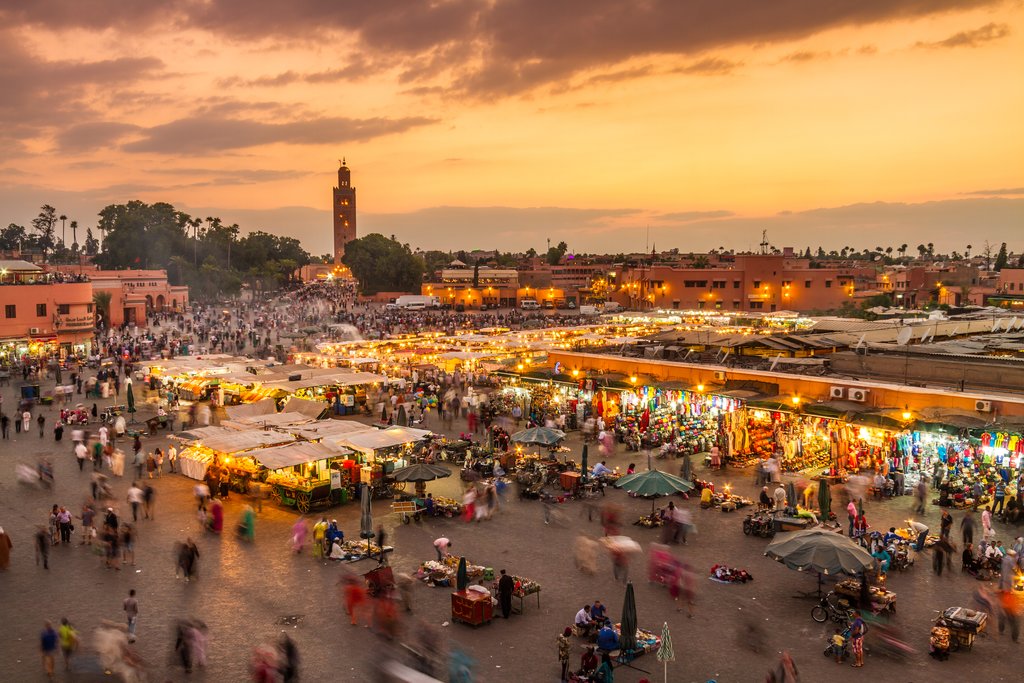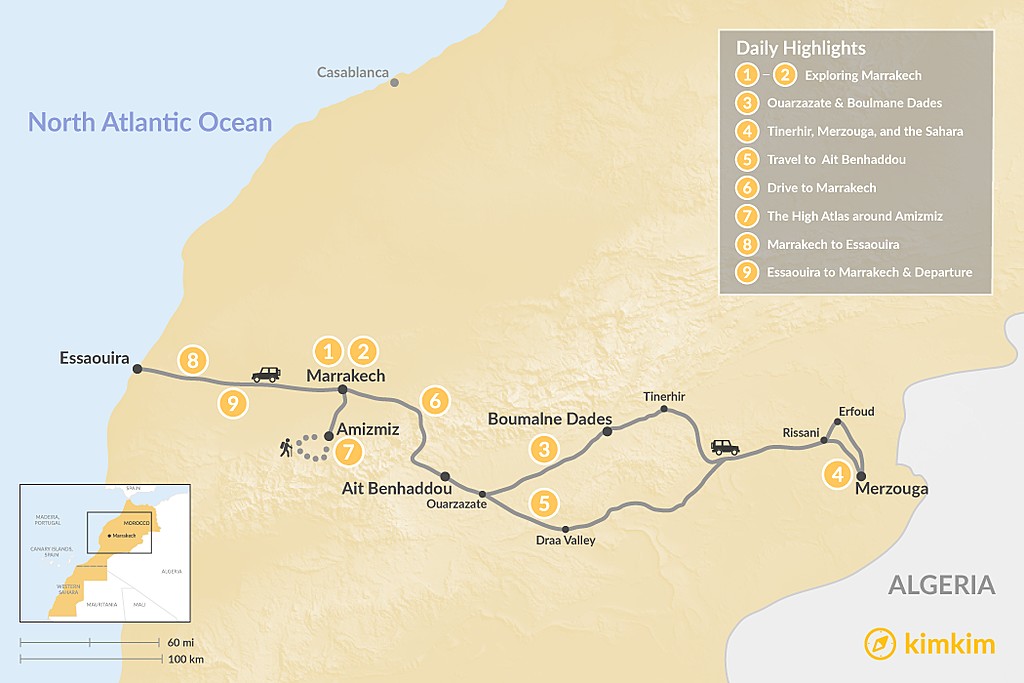Highlights
- Wander Marrakech's old medina and maze-like souks
- Hike through villages in the Atlas foothills and spend a night with a local family
- Follow old caravan routes along oases and fortified kasbahs in Morocco's desert
- Climb Essaouira's18th-century ramparts and enjoy fresh seafood
Brief Itinerary
| Day | Highlights | Overnight |
|---|---|---|
| Days 1-2 | Discovering the "red city" of Marrakech | Marrakech |
| Day 3 | Over the High Atlas mountains and into the desert | Boumalne Dades |
| Day 4 | Desert towns and camping in the Sahara | Erg Chebbi |
| Day 5 | Date palms, Alnif, and Aït Benhaddou Kasbah | Aït Benhaddou |
| Day 6 | Ait Benhaddou, Tizi-n-Tichka Pass over the High Atlas, Marrakech | Marrakech |
| Day 7 | Hike the Atlas foothills, overnight in a Berber home | Amizmiz |
| Day 8 | Essaouira: Seaside ramparts, kitesurfing, and fresh seafood | Essaouira |
| Day 9 | Return to Marrakech & Departure |
Detailed Itinerary
Days 1: Marrakech: Exploring the Red City

Welcome to Marrakech! Nicknamed the "Red City" for its 1000-year old red sandstone city walls and buildings, Marrakech is a major economic center. Marrakech has Berber rather than Arab roots and was once an important trading capital for tribes of the Atlas mountains. Orient yourself around Marrakech's bustling Jemaa el-Fna Square: the souks (markets) are to the north, the Koutoubia Mosque and Gardens to the west, and the kasbah (fort or fortification) area with the Saadian Tombs, Bahia Palace, and El Badi Palace are to the south. In Ville Nouvelle, you will find the Majorelle Gardens.
For a unique way to tour the medina (old quarter), board a calèche (French for horse-drawn carriage) and begin to adjust to your surroundings. Notice the fondouks—medieval inns that provided merchants and travelers with shelter and supplies. Today some have been converted into residences or large shopping areas and workshops that you can explore. Find your way to the Koutoubia Mosque and take a respite from the heat in its gardens amid fountains and palms. Though the mosque cannot be entered by non-muslims, it's worth checking out its 12th-century foundations and minaret.
As the evening progresses, Jemaa el-Fna comes alive with musicians and storytellers, acrobats and dancers, and even snake charmers. Wander the many rows of food stalls serving anything from full meals to fruit drinks, dried dates, and small snacks. Grab a bite, or for a more relaxed experience, look for one of the many cafés that sit above the square to enjoy a meal while you watch the show below.
Day 2: Marrakech: Palaces & Souks

Meet your guide for a half-day tour and discover the exquisite detail of the Ben Youssef Madrasa school of Islam for a taste of 16th-century architecture. Admire the traditional Moroccan artisanship: carved cedar, sculpted plaster, arabesques, Islamic calligraphy, and colorful zellij (mosaic tilework). Wander the old dorms where up to 800 students once lived and visit the prayer hall.
Spend time exploring Dar Di Said Museum (also known as the Museum of Moroccan Arts) to see exhibits of clothing, antiques, jewelry, and beautifully carved Hispano-Moorish decorations. Afterward, indulge your senses as you explore the complicated labyrinth of souks, tucked behind ordinary restaurants and shops. Check out Souk el Attarin, Souk Chouari, and Souk Smata for a selection of spices, woodwork, and babouche (traditional Moroccan slippers). Visit Souk des Teinturiers (the dyers’ souk) to see firsthand how leather hides and cloth are dyed.
Day 3: Over the High Atlas Mountains to Ouarzazate & Boumalne Dades

Leave the busy city behind and head east toward the desert, ascending the High Atlas mountains. See if you can spot Mount Toubkal, the highest peak at 13,671 feet (4,167 m). Along the way, you will pass many Berber villages—made up of traditional mud-brick buildings. Lunch in Taddert and tour the local Argan Oil Cooperative and discover how the local women extract the precious oil from the argan nut to make oil used in the health, food, and cosmetic industries. Follow the winding road to the Tizi n'Tichka pass and stop to appreciate the panoramic view.
Continue east to the desert hub and filming location of Ouarzazate. Join a movie studio tour and discover which of your favorite movies were filmed in the nearby desert regions. Travel along the Valley of a Thousand Kasbahs towards Boumalne Dades, passing many small towns where you will see traditional farming methods in use. Be on the lookout for nomads tending to their animals as you make your way through fragrant Kela'a M'gouna, the "Valley of the Roses". You'll eventually arrive in Boumalne Dades, a major town bridging the Dades River.
Day 4: Desert Towns & Camping in the Sahara

Today you will drive further east to your final destination: the sand sea of Erg Chebbi outside of Merzouga. Along the way, stop in Tinerhir to admire the river oasis that extends on either side of the town. The surrounding desert landscape reveals impressive buttes, mesas, and plateaus. Nearby, you will have the opportunity to explore the Todra Gorge, a 984 feet (300 m) deep ravine, cut by the Todra River. Continue to the desert town of Erfoud. Known for its figs and fossils, visit a craft workshop and discover how the fossil-rich rocks are skilfully transformed into practical and decorative objects.
As you near Merzouga—the town closest to the Sahara—stop in the market town of Rissani and be sure to visit the livestock auction as well as the "donkey parking lot". Leaving Rissani behind, you will start to see the beginnings of the massive dunes of Erg Chebbi, looming on the horizon. Upon reaching Merzouga, hop on a camel and ride into the desert to enjoy the setting sun atop a large dune. Return to your Erg Chebbi camp for dinner. Relax around the campfire listening to traditional Berber music and admiring the vast star-lit night sky before retiring to your Bedouin-style tent.
Chat with a local specialist who can help organize your trip.
Day 5: Date Palms, Alnif, & Aït Benhaddou Kasbah

Rise early to witness a Saharan sunrise, before exploring more of the Desert: rent a sandboard, join the Erg Shibi tour (around the sand dunes), or a quad ATV tour. Head south to Khemliya to explore this traditional Saharan village. You will have a second chance to stop in Rissani to visit Maison Tuareg, a storehouse selling traditional carpets, jewelry, and leather goods. From there, pass through umbrella-shaped trees of the acacia forests before reaching Alnif for lunch. Continue on through the Draa Valley, dense with date palmeries and the opportunity to pick up a box of dates for the drive.
Continue west to medieval Aït Benhaddou, breaking up the trip with a stop in Ouarzazate. Movie buffs may appreciate a visit to the Musée du Cinema. A protected UNESCO site, Aït Benhaddou is the most famous kasbah in Morocco and once held an important position along the trans-Saharan trade route between Marrakech, Ouarzazate, and the southern desert. Spend the night in the old town and wander the empty alleys after the day-crowds have left. Pay a nominal fee to enter a few of the kasbahs and climb up to the rooftop for pretty views of the surrounding ksours (individual kasbahs) and Ouarzazate Valley.
Day 6: Return to Marrakech

Before the crowds filter into the old kasbah, explore the narrow passageways and alleys to get a real feel for this 11th-century fortified city. Leave Aït Benhaddou behind, and return to Marrakech, traveling one more time up and over the High Atlas mountains and through the Tizi n'Tichka Pass. As you descend the north-facing slopes of the High Atlas you will notice a dramatic change in climate and landscape. After all the tranquillity of the mountains and the desert, soon you will be in lively Marrakech.
You may want to spend the rest of the afternoon at a slower pace. Visit Jemaa el-Fna and grab a bite to eat at one of the many food stalls. Take an evening stroll and walk the short distance to admire the floodlit Koutoubia Mosque, before retiring to your accommodation.
Day 7: Hike the Foothills around Amizmiz & Stay the Night in a Berber Home

Today you will venture south of Marrakech to the small town of Amizmiz in the foothills of the High Atlas mountains (about one hour south). Spend time exploring the modest market in the old town before joining your mountain guide to trek the narrow roads and mule paths in the surrounding hills. Hike between small Berber villages and observe the local farmers and shepherds as they tend to their animals and the landscape. You may even see children on their way to or from school, which are typically shared between a few nearby villages.
Stop and enjoy lunch with a local family and gain insight into their daily lives as you learn how to make homemade bread. Continue your hike into the afternoon before returning to another local Berber home where you will be welcomed for dinner and provided with a room to retire for the evening.
Day 8: Essaouira: Seaside Ramparts, Kitesurfing, & Fresh Seafood

After breakfast, make your way west to the Atlantic coast and to the charming beach town of Essaouira. The route along the way takes you over extensive rolling plains and through endemic argan forests. If you're lucky, you may see goats in the trees grazing on the argan fruit, a sight seen when grass pasture is limited or unavailable. Along the way, there is an option to stop at an Argan Oil Cooperative to see how the precious and expensive oil is extracted from the nut.
Arrive in the port city of laid-back Essaouira, a nice contrast to frenetic Marrakech, and spend the rest of the day as you choose. Peruse the UNESCO-protected medina, ride horses in the surf, take a kitesurfing lesson, or walk the Skala de la Kasbah (the 18th-century seafront ramparts) along the coast. Designed by European engineers, old brass cannons line the walls and offer viewing access over the Atlantic. Jimi Hendrix fans may want to take a short taxi ride to Diabat at the end of Essaouira's beach where he reportedly spent some time. Walk back to Essaouira and enjoy a meal of freshly caught seafood.
Day 9: Return to Marrakech

Known as the "Windy City" for its strong Alizée trade winds that hit its crescent beach, Essaouira is a popular surfing destination. Take the morning to watch the windsurfers, surfers, and kiteboarders or for the more adventurous, take a lesson, before saying goodbye and returning to Marrakech.
Depending on your flight details you may wish to explore the kasbah area south of Jemaa el-Fna. Check out the Saadian Tombs and discover the 500-year old craftsmanship that went into its construction. Visit the sunken gardens of the 17th-century El Badi Palace as you work your way through the Mellah (Jewish quarter) and to the 19th-century Bahia Palace. Visit the only surviving Almoravid monument, the 12th-century Almoravid Koubba, before spending some time in the Marrakech Museum, housed in the 19th-century Dar Mnebbi Palace, and enjoy modern and traditional Berber and Moroccan art.


